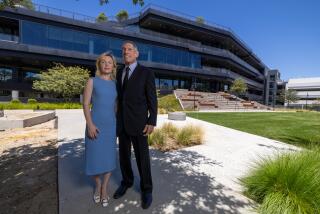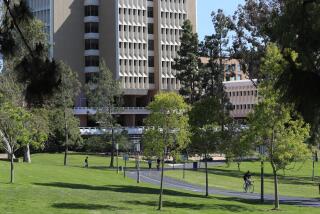$10.5-Million Building to Be 1st Addition to Salk Institute
- Share via
The Salk Institute for Biological Studies is planning a mid-1990 ground breaking for a $10.5-million building that will be the first addition to the La Jolla-based research facility that noted scientist Jonas Salk founded in 1960.
A third of the 54,000-square-foot building will be dedicated to laboratory space for institute researchers who, during the past few years, have been bolstering research into the AIDS virus and brain functions, institute spokeswoman Diane Carter said Monday. The rest of the building will house administrative and meeting space “essential to rapid progress in today’s research,” Carter said.
Expanded Staff Planned
The building will “allow the institute to take full advantage of today’s exceptional opportunities to advance biomedical research,” Carter said. The institute will “gradually expand” its staff when the new building is completed in 1992. The institute now employs 500 people, including 200 with doctoral degrees in science and medicine.
The institute will dedicate some of the new laboratory space to expand research into how the AIDS virus enters cells, how the virus reproduces once it enters cells, and how the virus destroys immune system cells. The building also will house researchers studying basic brain functions that scientists must understand before developing cures for Alzheimer’s disease, multiple sclerosis, schizophrenia and other maladies.
Although the institute has needed more space for expanded research, the institute’s directors have been “very sensitive” about adding a building that might clash with the institute’s existing complex, Carter said.
The original buildings, which feature a masterful blend of glass, teak and concrete, have been described by critics as an architectural masterpiece. Two identical laboratory buildings that face each other across a plaza provide the focal point for the research campus that was designed by the late Louis Kahn, an internationally renowned architect from Philadelphia.
The building will be designed by Jack MacAllister and David Rinehart, principals with the firm of Anshen & Allen. MacAllister “worked on site with Mr. Kahn,” Carter Said. “He is very sensitive to our concerns.”
Founded in 1960
MacAllister’s design evidently will borrow from sketches that Kahn completed while designing the original buildings, Carter said. “We think the design worked out very nicely,” Carter said. “The design has been widely accepted in the architectural world.”
Salk founded the institute that bears his name in 1960, largely with funds from the March of Dimes, which had funded much of Salk’s polio vaccine research. The institute’s six major research areas are the Cancer Center, the Center for Human Heredity, the Brain Research Center, the Center for Molecular Medicine, the Center for Plant Biology and the Center for AIDS Research.
Money distributed by the National Institutes of Health and other federal agencies accounts for about two thirds of the institute’s $33-million annual budget. About a third of the $10.5 million needed to build the building has been raised, Carter said.
More to Read
Sign up for Essential California
The most important California stories and recommendations in your inbox every morning.
You may occasionally receive promotional content from the Los Angeles Times.













